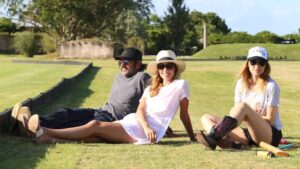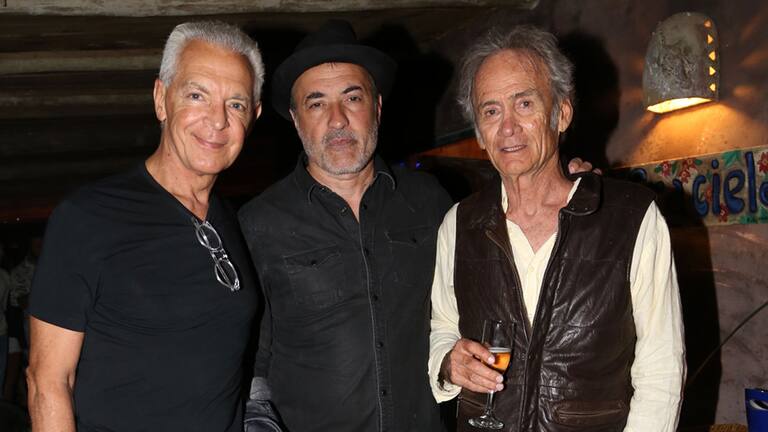When in 1998 Jorge ‘Corcho’ Rodríguez purchased Yellow Rose, a beautiful estate in the heart of La Barra, Punta del Este, it made headlines in all the magazines. Not only because of the enchanting surroundings, but also because of the love story that came with it: the yellow roses had captured the heart of the number one diva of our television, Susana Giménez, with whom the businessman had a fairly publicized relationship at the time.
Over time, and after separating from Susana, Jorge ‘Corcho’ Rodríguez dedicated himself to giving new meaning to that place and that name: Yellow Rose is no longer hidden from curious eyes. Anyone traveling along the Camino del Cerro Eguzquiza, the best road to reach San Carlos, can see the large sign on the wooden gate, and it is no longer a tribute to Susana; it is one of the most beautiful country houses in the East, which in recent years has sought to open its doors: it inaugurated a polo club and a winery.
To showcase his work in favor of Uruguayan polo and celebrate his debut as a winery entrepreneur, Corcho organized a great barbecue at Yellow Rose over the weekend, but he didn’t warn most of the guests about the presence of a house wine on the table. The wine circulated among the hundred guests without a label, sparking curiosity because there were experienced liquor tasters who discovered a new flavor there. “That’s how I got very genuine feedback. Adolfo Cambiaso Sr. and Eduardo Costantini loved it and already ask me where to buy it,” Jorge ‘Corcho’ Rodríguez told LA NACION.
Together with Verónica Lozano, they were luxury hosts of a night designed for enjoyment: the starry sky, the barbecue cooking on the fire a few meters away, the family atmosphere, good music, a true gathering of friends. Federico Alvarez Castillo and Lara Bernasconi, Luciana Salazar, Pampita Ardohain, Julieta Kemble, Vanesa Kreth, Teresa Calandra, and others close to the couple were among those who attended.

Having a vineyard at home means much more to Corcho Rodríguez than just indulging the palate. He’s deeply interested in production and is very involved in the process of creating a quality product. In conversation with LA NACION, he mentioned that they’ve been working on producing wine for seven years now. “First, we conducted a soil test with Caterina Viña, the winemaker. We saw that we could plant three varieties: tannat, merlot, or pinot noir. I like pinot noir because it’s smooth, full-bodied. We set ourselves a working model that is very similar to a Romanée Conti wine,” he said, and the reference to one of the world’s most expensive wines doesn’t intimidate him. “Yes, we set the bar very high, but we’ve embraced it because we want to continue with that approach.” The results, however, support that aspiration: the first production in 2011 yielded a thousand bottles because they only harvested the grapes that were perfect, meaning they discarded almost 70% of the fruit. “It’s not commercial initially, but we gain in quality in the medium and long term.” In 2012 and 2013, there was no wine because the grapes weren’t in good condition. Now, they’re aiming for 5000 bottles.
The plants were brought from Burgundy, France, and occupy four hectares of land, which at first glance is very minimally intervened by the “industrial” part. “They don’t have irrigation, we let them grow strong and coexist with nature without irrigation, without chemicals. It’s not organic, but it’s as natural as possible,” explained the businessman, who reveals himself as a true expert in production. He says he’s always been drawn to understanding the process and, of course, knows how to enjoy the flavors that Bacchus’s drink offers. “I have friends who have wineries in Argentina and different parts of the world. I like to try them out; I’ve always found it interesting because you can add your own touch. You keep trying and see how you like the wine, and then you keep producing it,” he added. For now, he doesn’t have very ambitious commercial objectives and hasn’t sold any bottles. This year’s production will reach 5000 bottles, and he plans to distribute them among family, friends, and start placing them in some restaurants. “The idea is to sell it exclusively, so that people request it through a website, put it in some specific places, key restaurants that we like because we’ve traveled and known them. I’ve had many people at the Hotel Bristol in Paris, Fasano in Brazil, Cipriani try it, restaurants that I like and we’ve offered them the wine, and they liked it,” he explained.
Furthermore, committed to his polo club, which can be visited because it is registered with the Polo Association of Uruguay, he will release a book about Yellow Rose to showcase the work with his horses, the goals achieved as a club, and the lifestyle of the country house. That book will be distributed with the wine, which no longer states on its label what varietal it is. “It’s the house wine, Yellow Rose wine,” he concluded.
Veronica Lozano Veronica Lozano Veronica Lozano Grupo La Roca Grupo La Roca Grupo La Roca








